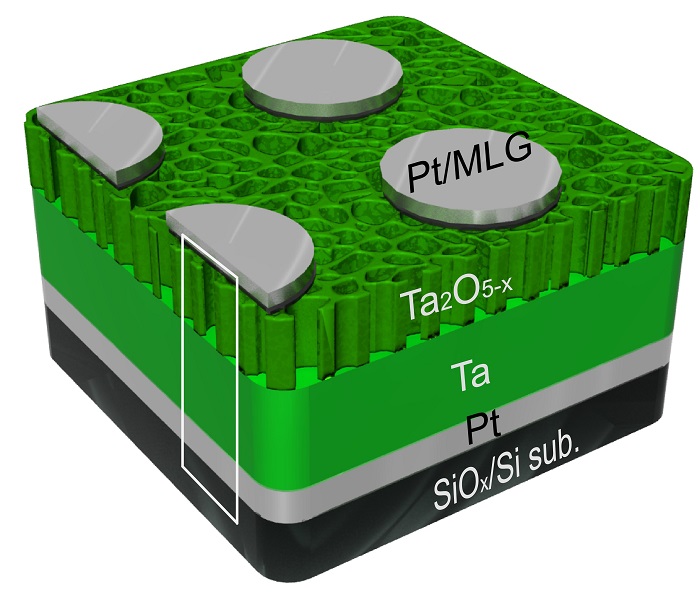A new approach to solid state memory technology, introduced by scientists from Rice University, is said to allow for high-density storage with a minimum incidence of computer errors. A schematic shows the specially layered memory device, which overcomes crosstalk problems that cause read errors in other devices.
A schematic shows the specially layered memory device, which overcomes crosstalk problems that cause read errors in other devices.
The technology, developed in the Rice lab of James Tour, is based on tantalum oxide, a common insulator in electronics. When the team applied voltage to a 250 nanometer-thick sandwich of graphene, tantalum, nanoporous tantalum oxide, and platinum, the result was the creation of addressable bits where the layers met; specifically, control voltages shifted oxygen ions and vacancies which, in turn, switched the bits between ones and zeroes.
Should this approach prove scalable, the technology could allow for crossbar array memories that store up to 162 gigabits, a count significantly higher than other oxide-based memory systems currently being investigated.
What’s interesting about the Rice team’s discovery is the fact that the device requires just two electrodes per circuit; this means it’s much simpler than present-day flash memories (which use three).
“But this is a new way to make ultradense, nonvolatile computer memory,” Tour said. For those not familiar, nonvolatile memories hold onto data even after the power’s been shut off, as opposed to volatile random-access computer memories, which lose their data once the machine’s been turned off.
Today’s memory chips come with a lot of requirements: for one, they have to be able to read and write data at speeds faster than ever before. They also need to be able to store more data than their predecessors. They need to be durable and they also need to demonstrate the ability to retain data using minimal amounts of power.
Tour believes his team’s new design which, it should be noted, uses 100 times less energy than modern-day devices, can meet all these requirements.
“This tantalum memory is based on two-terminal systems, so it's all set for 3-D memory stacks,” he said. “And it doesn't even need diodes or selectors, making it one of the easiest ultradense memories to construct. This will be a real competitor for the growing memory demands in high-definition video storage and server arrays.”
Taking a closer look at what, exactly, they created here, the layered structure is made up of tantalum, nanoporous tantalum oxide, and multilayer graphene between two platinum electrodes. When they were making this material, the team found the tantalum oxide slowly loses oxygen ions which, in turn, resulted in it changing from an oxygen-rich, nanoporous semiconductor at the top to oxygen-poor at the bottom. Where it (the oxygen) disappears completely, the result is pure tantalum (a metal).
During the course of their research, the team was able to distinguish three related factors that give the memories their unique switching ability:
1) The control voltage mediates how electrons pass through a boundary that can flip from an ohmic (current flows in both directions) to a Schottky (current flows one way) contact and back.
2) The boundary’s location can be changed based on oxygen vacancies; that is, they’re “holes” in atomic arrays where oxygen ions should exist, but don’t. The voltage-controlled movement of these holes shifts the boundary from the tantalum / tantalum oxide interface to the tantalum oxide / graphene interface. “The exchange of contact barriers causes the bipolar switching,” said Gunuk Wang, lead author of the study and a former postdoctoral researcher at Rice.
3) The flow of current draws oxygen ions from the tantalum oxide nanopores and stabilizes them. These negatively charged ions then produce an electric field that serves as a diode which, in turn, hinders error-causing crosstalk. These types of arrays have been limited to about a kilobyte because denser memories suffer from crosstalk, which results in bits being misread.
The graphene in the team’s layers performs double duty, serving as a barrier that keeps the platinum from migrating into the tantalum oxide and causing a short circuit.
Tour added that tantalum oxide memories can be created at room temperature. He also said the control voltage that writes and rewires the bits is adjustable, which allows for a rather expansive range of switching characteristics.
Looking ahead, Wang said that two of the hurdles that stand between where they are today and commercialization of this technology is the fabrication of a dense enough crossbar device to address individual bits, and a way to control the size of the nanopores.
You can read the team’s published report in the American Chemical Society journal Nano Letters.
http://pubs.acs.org/doi/abs/10.1021/acs.nanolett.5b02190
Via Rice University
Advertisement
Learn more about Electronic Products Magazine





